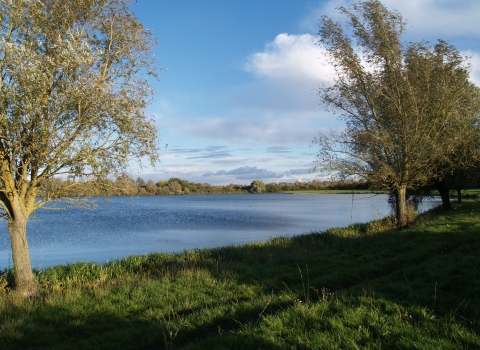Habitat restoration work, about to start at Godmanchester nature reserve, will enhance lake edge channels, existing shallow water and the scrapes (shallow water dips) which are important for all the birds that feed, breed and shelter on the site - and the more complex and muddy the edges the better for wading birds. These improvements have been made possible with a grant of £9,540 from the Cambridgeshire Community Foundation/Anglian Water Flourishing Environment Fund, and initial work involves use of a digger on site to redefine lake channels and edges.
Matt Hamilton, Senior Reserves Manager for Cambridgeshire, said: “Godmanchester nature reserve is a beautiful spot south of the River Great Ouse and is very popular reserve with local residents. It’s already home to a range of species that take advantage of the lakes, grasslands and hedgerows and now we’re improving that habitat so the site can provide more opportunities for ducks, wading birds and other species. Making changes to the lake edges will mean birds have more opportunities to nest and feed.
“Winter is an ideal time to carry out this work so disruption for wildlife is kept to a minimum – there will be some machinery operating on site while we work but by the time spring comes we hope visitors will start to see the benefits of this works as species become more active, build nests and gather for food for their hungry broods.”
Planned work includes:
- Reedbed cutting to maintain a varied structure important for invertebrates and birds, plus removing establishing young willow that would result in the loss of reedbed through shading and drying out.
- Willow tree pollarding around the lake edges (cutting back crowns at 3m plus height) to create a new generation of traditionally managed trees, increasing deadwood and hole nesting habitat resources and complement the existing old pollard willows.
- Clearance of vegetation from those islands in 'Island lake' – these islands provides essential safe spaces free from mammal predators for nesting birds such as oyster catcher and lesser black backed gulls and others as well as a safe roosting site for many other bird species.
Several years ago, when constructing the original channels from the lake into surrounding grassland, the resulting spoil was used to build a temporary soil bund which acted as a screen while restored hedges became established. This bund screen is now no longer needed and will be removed, presenting the opportunity to restore some of the channels and create a more varied lake edge. Relocating the bund spoil to the lake edge will make new shallows: the previous lake edge being very uniform, providing only limited space and opportunities for birds. The results will enhance visitor experience, improving the view from the bird hide of all wading birds on the lake edge.
Chris Gerrard, Natural Catchment & Biodiversity Manager at Anglian Water, said: “Our commitment to the environment is at the heart of everything we do at Anglian Water, and a really important part of that is safeguarding our region’s biodiversity.
“We know that we have a responsibility to conserve the natural environment while carrying out our work, but we’re also investing £40,000 through our Flourishing Environment Fund to actively encourage and enhance biodiversity. This scheme in Godmanchester will improve conditions for birds and other wildlife at the nature reserve, many of which are rare and protected species, as well as promoting new plant growth.”


